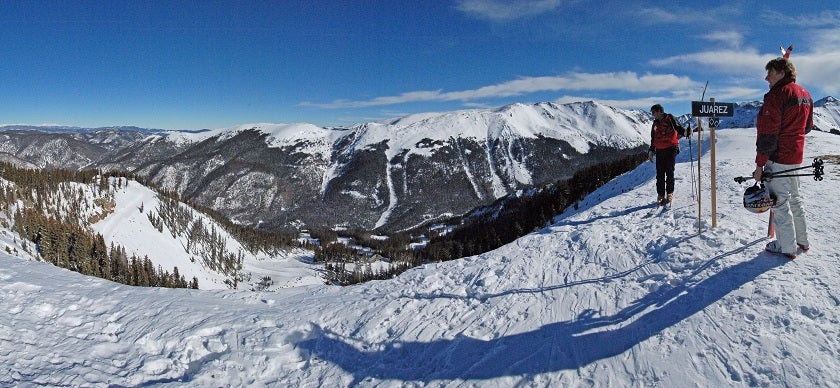
Ernie Blake, founder of Taos Ski Valley, with his wife, Rhoda, in an undated photo. (Courtesy Taos Ski Valley)
TAOS, N.M. (JTA) – One of the most wonderful things about skiing is the sense of seclusion, the incomparable quietude and serenity of standing atop a 12,000-foot peak surveying miles and miles of snow-covered emptiness. Somehow the prosaic concerns of the everyday world don’t seem to reach there.
So when I scheduled a few days off last winter from my job as editor of a 24/6 Jewish news outlet to go to Taos Ski Valley in a remote corner of New Mexico, I was looking forward to being completely disconnected from my work life. BlackBerries don’t work on black-diamond slopes.
But one evening apres ski, I made a rather unexpected discovery while flipping through the local coffee table book on the history of Taos. The ski area’s legendary founder, Ernie Blake, whose family still owns Taos, immigrated to America from Germany in 1938. My parochial instincts immediately perked up.
It turns out the timing was no mere coincidence. Blake’s original name was Ernst Hermann Bloch, and the family left Nazi Germany on the eve of World War II because he was Jewish. His remarkable journey took him not just from the Alps to the Rockies, but from a life as an Olympics-caliber German athlete to an interrogator of Nazis in the U.S. Army to founder of a world-class ski area in a state better known for its deserts.
Like so many other Jewish refugee families from Europe, the Blakes assimilated in America. Though he married a Jewish woman and had a bar mitzvah, Blake didn’t talk much with his family about his Judaism, and his descendants no longer really consider themselves members of the tribe.
“We didn’t know we were Jewish, essentially; we didn’t pay any attention,” one of Blake’s daughters, Wendy Stagg, told me. “We did Christmas in a secular fashion. We gave gifts and had a tree. My younger brother is active in Christian churches. The rest of us are essentially agnostic or non-believers.”
But if not for Blake’s religion, he may never have come to America and there would have been no Taos Ski Valley, one of the last family-run ski areas in the country.
The way I saw it, I owed my ski trip to Blake. So between rides up Kachina Peak (elev. 12,481) and runs down Upper Totemoff, I resolved to find out more about this Jewish man behind New Mexico’s largest ski mountain.
Born in Frankfurt in 1913 to a Swiss mother and a German father, Blake spent most of his childhood in Switzerland, where his athletic prowess bloomed on the slopes of St. Moritz and as a hockey player on the ice ponds nearby. If not for his religion, he would have been a shoo-in to be on the German ice hockey team in the 1936 Olympics, which also happened to be the first Games to include alpine skiing.
Blake actually met Hitler once, in January 1933, when Blake, then a pilot in the Swiss Air Force, went to hear Hitler give a speech in Frankfurt shortly before his appointment as German chancellor.
“We were not impressed,” Blake recalled years later in an interview with Rick Richards, author of “Ski Pioneers: Ernie Blake, his Friends and the Making of Taos Ski Valley.”
Blake’s family had never been religious, but that didn’t make any difference in Nazi Germany. In 1938, after a visit by the Gestapo to the family home, Blake’s father made the fateful decision to move the family to the United States.
The 25-year-old Blake ended up in New York, where he took a job in the winter department of Saks Fifth Avenue. On weekends he’d ride the so-called snow train to the Adirondack Mountains to teach skiing.
At the time, the ski industry in the United States was in its infancy. Skis were made of wood, not the fiberglass composites they are today, and until the first rope tow was installed in Vermont in 1934, downhill skiers had to climb the mountain themselves. The first chairlift went up in 1936 at Sun Valley, Idaho.
It was in December 1940 at the top of a chairlift on Mount Mansfield in Stowe, Vt., that Blake met the woman who would become his wife: Rhoda Limburg, a Jewish World War I orphan from England who had been adopted by a Jewish New York state Supreme Court justice.
It wasn’t quite love at first sight, but by summer Blake would follow Rhoda to Santa Fe, where Rhoda was taking art classes. The trip afforded Blake his first glimpse of the Taos area — then little more than a sleepy town near one of New Mexico’s active native American pueblos.
That summer the couple decided both to marry and make New Mexico their home. Rhoda, 93, still lives there. Blake died in 1989.
On their honeymoon in Sun Valley, the pair encountered a problem common to ski enthusiasts, which Rhoda said almost ended in divorce: She wasn’t a skier, and he couldn’t abide spending his honeymoon on the bunny hill. They resolved to ski apart, and the marriage held together.
With war raging in Europe, Blake soon joined the U.S. Army as an intelligence officer, interrogating top Nazis, including Hermann Goering, in his native German. Concerned about his Jewish-sounding name, the Army had him change it to Blake.
Blake flew to Europe on the day of the Normandy invasion and joined Gen. George Patton on the front. He was with the Patton when the U.S. Army encountered the first Nazi concentration camp in 1945. The experience, Blake’s son Mickey said, always haunted his father.
Nevertheless, Blake never felt comfortable identifying outwardly as Jewish – though it’s said that he gave generously to the local New Mexico UJA — and Blake kept his new name after the war.
“I feel it’s not fair to be marked, to wave a flag and allow others to make judgments before they know who and what you are,” Blake said in an interview for Richards’ book.
By 1949, Blake and his wife had settled in Santa Fe, where his ski career took off. Blake helped run both the Santa Fe ski area and Glenwood Springs ski basin in Colorado, traveling between the two in a small plane he piloted himself. It was on these trips that he spotted the remote peaks about 20 miles northeast of the town of Taos. He decided to start his own ski area there.
At first, people thought he was crazy. Aside from the logistical challenges involved — getting permits from the National Forest, carving ski runs, buying equipment, hiring staff — there was no established market for skiing in the area. The closest big city was Albuquerque – a place that wasn’t all that big, didn’t have many skiers and had its own local ski hill much closer by. Taos was more than three hours away.
But Blake persisted, and Taos gradually took shape, from a ski hill with little more than a rope tow and a couple of steep runs to the world-class ski area it is today, with 1,300 acres spread over 110 trails serviced by 13 lifts. The area, in the Sangre de Cristo range of the Rocky Mountains, averages about 300 inches of snow per year.
Taos’ distance from a major city and its operation by the Blake family has helped keep its intimate feel. It doesn’t have a ritzy atmosphere or cookie-cutter base village, and it lacks the crowds that have made skiing at other resorts as much about waiting in line as schussing.
Blake’s legacy is still palpable on the mountain. Four ski trails are named after the German officers who tried to assassinate Hitler in July 1944. One slope, Al’s Run, is named for a Jewish doctor friend of Blake’s who supported the development of Taos and so loved skiing that he kept going even after a heart condition forced him to take to the slopes with an oxygen tank strapped to his back.
And, of course, the mountain is still filled with Blake family members, whom you might spot working the register at the cafeteria, as Stagg does, or leading a ski lesson for kids. Until Blake’s death, he was doing some of those things himself.
“It’s a family business,” Stagg says.
One instructor I had recalled the radio spots Blake used to run late in the season, when the spring thaw already had begun. The skiing might not be so good, he would acknowledge in his thick German accent, “but ‘dere are still plenty of girls and ‘dere is still plenty to drink.”
“People here have very vivid memories of him,” said Sam Sokolove, executive director of the Jewish Federation of New Mexico. “He was a larger-than-life character.”
Despite the absence of a Jewish Blake legacy, there’s still some Yiddishkeit at Taos. Last Rosh Hashanah, when Sokolove and a few friends were looking to put together a spiritual retreat, they chose Taos. They brought prayerbooks, hired a rabbi and davened in the shadow of Ernie Blake’s magnificent mountain.
JTA has documented Jewish history in real-time for over a century. Keep our journalism strong by joining us in supporting independent, award-winning reporting.






